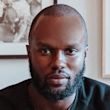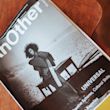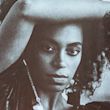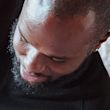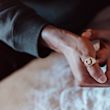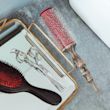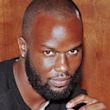"I was born in Brooklyn, New York, and raised in Jamaica—the island—until I was 10 years old. Then we came back and moved to Jamaica, New York. [I knew I was interested in hair] when I was five or six. I used to hang around in the salon near the house I lived in, and instead of playing outside, I watched all the women come in and out with their different hair styles. I was astonished by all the colors and shapes and how provocative it was. I started sweeping hair in the salon when I was seven. Sweeping turned into washing hair, and washing hair turned into, 'Oh, you need to learn how to do this.' I learned how to braid, how to roll a set—all the basic things—and it grew from there.
My sister was my guinea pig. I did her hair every two or three days, because I was like, 'Let me try this, let me try that.' I’ve always been in love with music videos so I tried to emulate the hairstyles in music videos on my sister. She went to school every day with a completely different look. The teachers were alarmed and my mother was just like, 'Oh my gosh.' [My family] was very supportive from day one. I come from a very artistic family—my mother is a reggae singer, my two aunts are reggae singers, my other aunts were heavy into dancing. They were into the arts and hair and beauty so I think naturally they were just like, 'Well, great. We have another one of those.'
[When we moved back to New York], I went to school in Queens. It’s such a melting pot and there are so many different cultures so I was exposed to new styles. One day, my sister was somewhere in Brooklyn walking by a salon, and the owner came out and asked, 'Who did your hair?' She said, 'My brother.' The woman didn’t believe her! Then she asked, 'How old’s your brother?' And she said, 'My brother’s 16.' My sister had a full head of extensions, and I don’t think she really understood how a 16-year-old boy had done that. I went in and met with her, and I ended up being her apprentice for a while. Then when I was 17, my mom sent me to Florida for the summer to stay with cousins who own a chain of hair salons. That’s when I started taking clients.
I had a moment where I felt like hair wasn’t sophisticated enough, like I needed to be on Wall Street or something. I become obsessed with wanting to work in fashion buying and merchandising. After I graduated high school I went to a two-year college upstate where I studied fashion and then I went to FIT. I paid for FIT by doing hair. The hair business was booming, and I got into a salon as an assistant while I was in school. Then I got promoted to a chair while I was still a full-time student, and I was making six figures. I graduated from school in 2009, got a job in fashion merchandising, and it paid one fourth of what I was making in the salon, so I left fashion and went back to hair. I started assisting in 2010. Taking the pay cut from that to assistant was horrible. I used to shop at Barneys—I had to change my whole life. It was a big jump. But, after every show, every shoot and every flight, I felt like it fed me. I wanted to learn as much as I could. It was very eye opening and made me want to learn more and do more.
When I was transitioning out of assisting, I started doing the underground stuff for ads. So if Balenciaga booked someone to do the ad, I would do the prep, which involves the braiding and all that stuff. I did that for a couple months. An agent saw some of my tears online and contacted me. I started working with him and I would do little things, and then those little things turned into 'OK, I'm going to start doing my own thing.' I was always heavily influenced by fashion...I was obsessed with Vogue and obsessed with Versace and Moschino ads. When I saw a Moschino ad with Alek Wek, I knew I wanted to work in fashion. She looked like a doll—she had this big afro and was wearing leopard print, and I said, 'I want to be the person who’s doing the hair for that.' I know that a lot of people feel like she’s the first person in fashion who looked the way she did. She made a lot of people feel at home and welcomed. I worked with her last year, and I was trying to explain this story to her. Halfway through the story I was like, 'You probably hear this all the time. I just love you.' [Laughs]
There’s a vibe in London that you can’t really get [in NYC]. When you’re a new artist, you want to be inspired. You can be a young hairstylist in London with no tears and if you meet the right person you can do the cover of something the next day. I think in New York there’s more of a structure. In London, people are more open to taking chances on new talent. I didn’t know who did the hair on fashion shoots, but eventually I learned that Sam McKnight did the hair for Moschino and then I came across Luigi [Murenu]. I got their agency information from someone and I emailed them for like a year before anybody got back to me. When I want something, I get very obsessive about it. I also reached out to Guido [Palau]’s team, and then I started working on shows with him. I transitioned out of that team and did a few weeks with Luigi, and then I transitioned out of that and went back to Guido, and then I worked with Sam. I also worked with Paul Hanlon who was amazing. It was really insightful to get to see how different people work. That whole period taught me a lot. I think that’s why my style is a little bit more [versatile].
I’ve been on my own since 2013. I learned that what I needed to improve, first and foremost, was my kit. I saw all these people with all this stuff in their kits, and I was so used to doing everything with like, four things. I wasn’t prepared to go to Europe the first time—I brought all my American tools. At one Fendi show, I blew the whole thing. Also, there was a thing about black hair in fashion that I learned as well—no one really knew how to do black hair in fashion. There were all these black models that would come with their hair kind of done already and they would ask me to re-do their extensions for show season. I would go from the shows to the hotels doing these girls’ hair—it became a thing. I know how to do black hair, I know how to do Jewish hair, I know how to do white hair, I know how to do Greek hair, I know how to do Asian hair. I know what you have to do for each type and I saw a lot of people who only knew how to do the type of hair that looked like theirs.
I think one of the things that [made natural hair more accepted] was in 2014 when Naomi Campbell, Beth Ann Hardison and Iman were calling out all the people that were discriminative of models of color over the years. After that, all these girls came out of the woodwork like Alek Wek, Liya Kebede, Lineisy Montero. What I like about the natural hair movement was that they were a bit aggressive, which is what was needed. There was this time where everyone was just like, 'That’s it. I’m tired of doing all these processes to fit into this mold, and to fit into what you think is beautiful. I’m beautiful like this.' I think there were a lot of women and men who were like, 'Let’s start a conversation about being the way we are.' It was really interesting to see that happen. It trickled into fashion for sure. No one was seeing it in fashion or in ads, but if you open up Vogue now, it looks completely different from how it looked five years ago. There are many models who get their careers hurt because of their hair, which is crazy to me. I’ve heard some stories where people cancelled models off big jobs that could’ve changed their lives, because there was no one that could’ve done the hair. I felt so bad for them. I always tried to do whatever I could to make sure that everything was alright for them on that front. If it was a situation where it was really busy and we were doing shows, I would take their information and say, 'When we get back to New York, come see me.'
[Shooting Iman in Jamaica] for US Vogue was the best thing ever. It was kind of crazy because I remember being young in Jamaica and reading US Vogue, and then I was in Jamaica shooting for them. That was one of the craziest turning points in my life. I’ve worked with Solange—I never know what mood she’s gonna be in and I love it. Sometimes she’s in a kinky mood, sometimes she’s in a straight mood, sometimes in a 'Let’s go blonde! No, platinum blonde!' mood. It’s always a treat working with her. I did Cardi B yesterday. She’s so used to a certain type of hair and a certain look. I completely changed that and made her a unit that had less hair in it than she’s used to. It looked more natural. At first she hated it—she was like, 'It’s thin, it’s thin.' And then towards the end of the day she was like, 'I kind of like this. Like, this part right here.' It’s just so crazy to see her slowly like it and then towards the end of the shoot she was like, 'I love this.' She kept the unit. I don’t know who she’s gonna try to make flat iron it to make it look that way again. [Laughs] But it’s so good to see people step outside their comfort zone, and do a different look that’s not really them. I think it’s great to be a little more flexible. I think my greatest strength as a hairstylist is that I can connect with models and clients before anything else. I think it’s good to feel people out and feel out what they want. It’s also important to learn your style, too. It’s good to be flexible and do certain things, but when you know you’re good at something, perfect it, and then make that your thing."
—as told to ITG
Jawara Wauchope photographed by Tom Newton on January 13, 2018.










